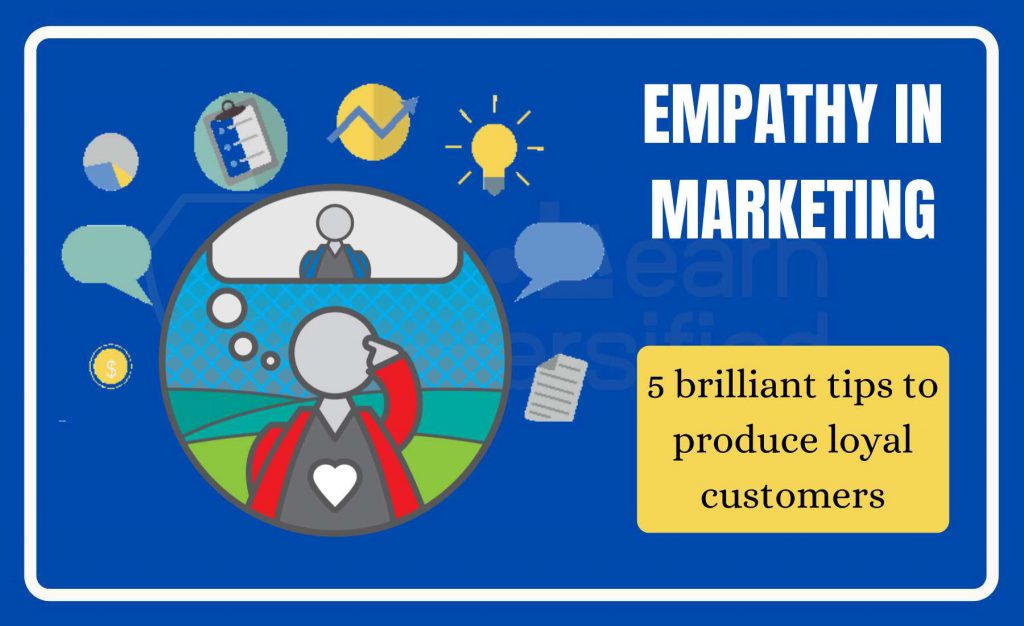In the present digital world, a normal individual goes through five hours out of every day on his/her mobile phone and how does a marketer reach them? More importantly, how does he catch their interest and enthusiasm to convert them into a customer?
Customers are insanely occupied, and they are very careful about deals pitches, cold messages, and promotion filled messages. The outcome of these activities blocks them out. So, what can a marketer do to turn them into loyal customers?
There is only one answer to all these questions which is ‘empathy’.
What does this mean?
Empathy is characterized as the ability to share and perceive the feelings felt by another being. In the context of marketing, empathetic marketing permits a marketer to comprehend his intended audience, make significant offers, and credibly engage with them.
It is otherwise known as Human-centered marketing and helps a marketer to make an association between his audience and the brand.
According to Dr. Brené Brown,
“Empathy is feeling with people.”
In the race to acquire leads, drive opportunities and move the sales needle, a marketer fails to notice the needs to address the emotional needs of his customers such as fears, hopes, wants, needs, aspirations, etc.,
At the point when a marketer puts himself in his audience’s shoes, it gets simpler for him to recognize the struggles faced by them and think critically about the best solutions and arrangements. That is the reason empathetic marketing is such a ground-breaking technique for both B2B and B2C businesses.
The neuroscientist, Antonio Damasio stated,
“We are not thinking machines that feel, we are feeling machines that think.”
He has also made an innovative discovery that when emotions are impaired, so is decision-making.
Fusing empathy in marketing reproduces the emotions through powerful and effective marketing campaigns that connect with and propel the motivation of his target customer group. It brings about creating faithful customers and more noteworthy business achievement.
Smart brands employ empathy marketing: looking beyond the functional to the emotional. — Molly Seaverns
So, a marketer needs to go beyond normal rationale based sales and marketing to see how his customers feel as empathy currently is, by all accounts, one of the requirements for ‘brand credibility ‘, alongside authenticity, authority, reliability, and unwavering quality.
Are you hoping to become a better marketer? Needing to boost sales and develop your business? Let us see how you can incorporate empathy into your present marketing strategy by the 5 brilliant steps listed below.
1. Be sneaky & Go undercover
Go to the places and stores where your products are used or sold as a mystery shopper and observe the people. By doing this, you will be able to measure the quality of sales and service your customer is experiencing from your brand stores and products.
2. Lurk and discover
Social listening is tracking your social media platforms for mentions and conversations related to your brand. By doing so, you can analyze them for insights and discover opportunities to act.
Use social listening to learn how people talk about the solution or product you offer. Understanding how people feel about your brand helps you to keep your marketing and product development efforts on track. It also allows you to respond in the right away to positive or negative posts.
3. Gather insights from the front lines
Customer delight means going above-and-beyond to create a positive experience with your product or brand that customers will sing praises for you.
Ask your customer service what drives customers crazy and what delights them. Knowing this, you can work on the features, or new products your customers would be interested in.
4. Change your point of view
Think about what success looks like from your customer’s perspective. You will be on the same page with your customers on what success looks like to them if you can leverage your services or products to help them reach that success and improve their likeliness to purchase from your company.
5. Outline the experience
Consider customers’ emotions before, during, and after use of your product. Monitoring these emotions, you can tell their preferences, satisfaction level, and tweak the features of your products accordingly. Customers are more inclined towards personalized and customized products than a generic one.
Conclusion
The drastic economic impact of COVID-19 has forced sales and customer teams to adapt in many ways. While economic uncertainty and monetary vulnerability keep on advancing, it’s increasingly significant that sales and marketing teams modify their strategies, procedures and approach conversations and interactions with empathy.
A business that invests in empathy devotes itself to understanding the emotional needs and motivations of its customers, and aligns itself to meet them.
The above lines are from the book “Empathetic Marketing” written by Mark Ingwer, who is a consumer psychologist and the managing partner of Insight Consulting Group.
Understanding a consumer’s wants, needs, disturbances, and complaints, will assist with setting your marketing efforts and campaigns differentiated from other companies. The true recipe and the genuine formula for marketing success and achievement is creating a connection and association from brand to consumer through the use of empathy.
For more interesting articles, click HOME.

